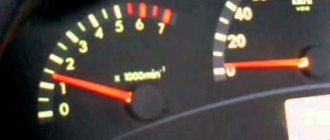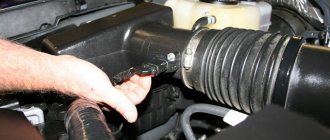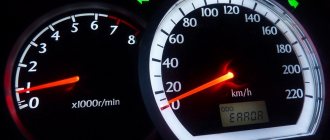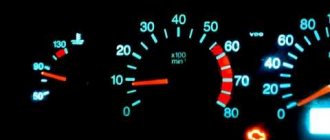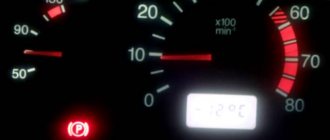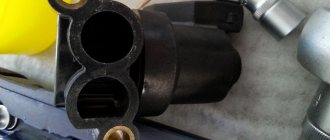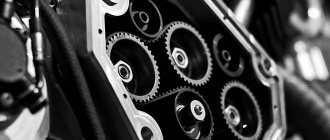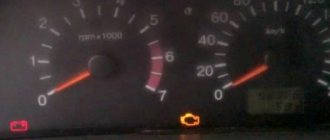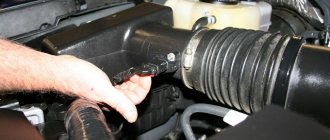After the owners try to start the engine in the morning, sometimes a problem arises: the idle speed of the Lada Granta fluctuates. This is considered one of the most significant shortcomings that arise in VAZ cars. If, after lengthy checks, it is discovered that the cause lies precisely in the throttle assembly, it is necessary to pay special attention to how air leaks through the connections of the intake receiver and the remote control.
Causes of engine tripping and their elimination
The Lada Granta engine suffers for a number of direct and indirect reasons. Vibration is not the main sign of a malfunction of the internal combustion engine. This is an indirect manifestation that should be considered along with others. For example, vibration may occur if the engine mount is worn out. To identify the cause of the problem, you need a complete diagnosis of the car.
The check begins with the fuel line, followed by the ignition and air supply systems. Sometimes it doesn’t hurt to test the correct operation of the ECM - perhaps the reason is incorrect readings from failed sensors.
Spark plug fault
One of the reasons for engine malfunction is late or early ignition, as well as failure to ignite the mixture caused by the absence or insufficiency of a spark. First you need to unscrew the spark plugs and inspect them. The spark plug must be replaced if there is visible damage to the insulator, this is immediately noticeable - the area turns black. Please also pay attention to compliance with the established standards for the gap between the two electrodes.
The next object to be checked are high-voltage wires. Since their insulation is made of rubber or silicone, over time the material dries out and cracks, resulting in “breakthrough” of the wires. A sign of this problem may also be the frequency of engine tripping, when after some time the engine operation stabilizes. Visually, a breakdown is easy to detect in any dark room: start the engine and open the hood - you will notice the glow of sparks on the wires.
The reason for the absence or insufficient spark may be a breakdown of the electronic ignition module. You will need an assistant to check its functionality. The spark plugs are unscrewed and secured to ground, and high-voltage wires are connected to them. After this, one person turns the engine with the starter, and the second looks for a spark.
Intake problems
The engine may stall due to insufficient air supply to the cylinders or, conversely, due to its excess. The main reason for such a malfunction is the loss of tightness of the intake system, which causes air to leak from the outside. The engine control unit does not take into account excess air, resulting in a malfunction of the motor.
Checking the intake system is not difficult. The easiest way is to pinch the air intake pipe near the air filter. If the system is working properly, the engine will start to stall, but if excess air is sucked in, it will continue to work. Based on the hissing sound, it will not be difficult to find the place where the system is leaking.
Another reason is insufficient air supply to the cylinders. The source of the problem is a dirty air filter. Lack of air may occur due to obstruction of the throttle valve or its incomplete opening/closing. Usually the problem is solved by flushing the throttle assembly or replacing it.
Sensor malfunction
One of the reasons for the tripping may be incorrect readings from the sensors of the internal combustion engine control system transmitted to the ECU. Due to incorrect parameters, the control unit does not regulate the throttle position. Because of this, he cannot calculate the correct composition of the fuel mixture, the engine begins to operate unstably or other problems are observed. A diagnostic scanner will help correct the situation, which will count errors that have occurred from the ECU and show which of the sensors has failed.
Fuel system malfunction
Diagnostics of the power system involves measuring the pressure in the fuel system and determining the presence of air. The level of fuel pressure depends on the normal operation of the fuel pump. The main reasons for this problem include the following:
- strainer (clogged);
- electric motor;
- fuel supply;
- pressure regulator on the fuel rail.
Problems with injectors can also cause unstable engine operation. They often become clogged with dirt coming from the gas tank. As a result, the correct atomization of fuel is disrupted, or it is supplied in insufficient quantities due to the reduced throughput of the injector.
To check the injectors for functionality and clean them, a special stand is used, on which flushing liquid is supplied through them under pressure. This method creates an imitation of the operation of the fuel system in real conditions, and evaluates its performance. The injectors can be cleaned and washed independently. It is allowed to use any flushing liquid. The nozzle must open in a timely manner when a pulse is applied and not leak. Gasoline should not flow - a working device sprays fuel, since this is the only way to achieve efficient combustion in the cylinders.
Checking the idle air control
| If the engine runs rough at idle, then the cause may be a faulty idle speed control sensor. Before replacing it, you can check the IAC with your own hands. |
The IAC is an actuator and its self-diagnosis is not provided for in the system. Therefore, if the idle speed control malfunctions, the “CHECK ENGINE” lamp does not light up. Symptoms of IAC malfunctions are in many ways similar to TPS (throttle position sensor) malfunctions, but in the second case, most often the “CHECK ENGINE” lamp clearly indicates a TPS malfunction.
Testing IAC using a multimeter
Checking the IAC with a homemade tester
However, you can make a simple device for checking IAC yourself. You only need a 6V AC transformer from your mobile phone charger. Using the switches alternately, we check the forward and reverse strokes of the IAC rod. If the unit is working properly, the lamp (6V/0.6A) barely shines. A bright light indicates that the rod is jammed and needs to be cleaned and lubricated or replaced. Detailed diagrams and seals from the author. If the IAC turns out to be faulty, then choose a new one. Photo source: Key words:
Floating engine speed
Engine speed problems can easily be identified by looking at the tachometer. Stable operation of the power unit at idle should not exceed 850 rpm. A small spread of 750 to 850 rpm is allowed. If the tachometer needle jumps chaotically—it goes down, then it goes up—there is a malfunction. This is a fairly common problem, and it is easy to identify why the speed of the Lada Granta is floating. It is enough to listen to the engine running - with unstable idle speed, the noise either decreases or increases.
The floating speed is also indicated by a characteristic vibration that will either subside or increase, transmitted through the engine compartment.
Why are the revs jumping?
The cause of the problem is the specifics of regulating the operation of the power unit at idle by the control unit. It continuously reads data about the status of various engine systems from sensors. If the idle speed becomes unstable, the sensors are given a command to correct the functioning of the system.
A malfunction of the mass air flow sensor may be one of the causes of the problem. During operation, it becomes covered with a thin oil film, the formation of which will certainly lead to breakdown. When excess air is sucked through the inlet into the cylinders, idle speed is disrupted. As a result, the air flow sensor transmits incorrect information to the ECU about the excessive consumption of incoming air. The failure is displayed on the dashboard - a “check”, or engine error, lights up on the screen of the Lada Granta’s on-board computer. In this case, the control unit commands the valves to admit more fuel into the cylinders and equalize the ratio of air and gasoline to prepare the optimal mixture. As a result, the speed increases sharply, and the ECU realizes that there is too much fuel and gives the command to limit the supply. As a result, the speed drops sharply.
IAC (idle air control) can also cause jumps in engine speed, in which case a “check” will light up on the dashboard. The regulator is an electric motor with a cone-shaped needle. Its direct purpose is to adjust and maintain stable idle speed. A faulty regulator stops working normally, and the engine, left without it, begins to randomly increase or decrease speed.
Unstable idle may be caused by a problem with the oil pan ventilation valve. Engine operation is accompanied by the release of gases that accumulate in the pan. If there is a large amount of crankcase gases, they are discharged through the ventilation system through the intake manifold to the throttle assembly. With their help, part of the air-fuel mixture is formed in the combustion chambers. If the valve loses its normal throughput, then less gases enter to enrich the mixture, and the speed begins to float.
IAC diagnostics, idle speed sensor
Use a pxx tester to verify the presence of floating rpm
To check whether the speed on the Lada Granta is floating, look at the IAC sensor. It is located on the throttle body, therefore, in the same place as the sensor responsible for the throttle position. It is secured with two mounting screws. In order to verify its functionality, one multimeter will be enough.
To begin diagnostics, you need to turn off the ignition and disconnect the block to which the wire from the sensor leads, and, using a multimeter, measure the resistance level between the contacts of the regulator.
If the vehicle readings are normal, it should be within approximately 80 ohms. In the same case, if the indicators turned out to be significantly higher than the IAC norm, it will be necessary to replace it.
The idle speed sensor, abbreviated as IAC, is the same idle speed control, or IAC. Its immediate purpose is to stabilize and automatically adjust the idle speed of the Lada Grant, which is used in the daily functioning of the car. In appearance, it is an electric motor equipped with a cone-shaped needle.
At the moment when the ignition is turned on directly, the rod located on the regulator fully extends and rests against a specially made calibration hole. It is located directly in the throttle pipe. After this, the sensor begins to count steps until the required time and returns the valve to its original state upon completion of operation.
It is necessary to take into account that when you start warming up the Lada Granta engine, the sensor readings should not exceed 50 steps. If their volume is much smaller or larger, it means that air volumes are constantly changing, which in the future can lead to significant damage.
Other reasons for unstable engine operation Grants
Floating speeds and tripping are not the only problems associated with the functioning of the Lada Granta engine. There are other situations.
Engine does not develop power
This problem is not relevant if the car is new and is being run-in. Until 5 or 8 thousand kilometers, the engine should not gain maximum power. And for the first 2 thousand kilometers, it is not at all recommended to raise the tachometer needle above the 3000 rpm mark.
It happens that when accelerating a car:
- does not gain the required power;
- moves as if there is a trailer behind it;
- When accelerating it sticks.
These are signs of low pressure in the fuel system. It is recommended to replace the fuel filter with a new one. The cause may also be low-quality gasoline. The Grant is equipped with an electronic gas pedal - its malfunction can also cause insufficient engine power.
Engine knock
A knocking sound in the engine may occur due to vibration of the crankshaft pulley. There is no point in repairing it; it is better to replace it with a new one. If the cause is a loose timing belt, you can fix the problem by tightening it. A knocking sound in the engine may occur due to a loose flywheel, but this happens quite rarely. Wear of connecting rods, bearings, pistons and crankshaft also leads to a characteristic dull knock. If the problem is with these components, then they require replacement.
Unstable engine operation can occur due to the natural wear and tear of engine parts or improper running-in. In any of the described cases, it is necessary to carry out a comprehensive diagnosis, with the help of which the exact cause can be established and then eliminated. To carry out self-diagnosis, you need a special scanner.
If the engine is misfiring, then it is not recommended to delay solving this problem. Driving with the engine partially working or not working at all is prohibited, as it can lead to more serious malfunctions and expensive (possibly major) repairs of the internal combustion engine.
Car : Lada Granta. Asks : Alexey Dudyrev. The essence of the question : Does the idle speed fluctuate?
I recently bought myself a Lada Granta, and the revs began to fluctuate, in short, the car became somehow unstable at idle. Tell me what could be the cause of this malfunction and how quickly it can be fixed?
Route map for eliminating unstable XX on a VAZ 2170
Unstable idle is caused by the fact that the computer incorrectly perceives or does not know at all the amount of air sucked into the intake manifold. A typical treatment recipe looks like this:
- Check the sensors (IAC, DFID, TPS) and replace the faulty ones.
- Make sure that the adsorber valve is in good condition.
- If, after cleaning the throttle valve on the VAZ 21126 engine, the speed fluctuates, you need to make sure that there is no air leakage through the connections to the pipes.
- Check whether the diaphragm in the vacuum brake booster is intact.
vote
Article rating
conclusions
As you can see, there are quite a lot of reasons for the occurrence of floating speeds, and to find out the final cause of this problem, you can simply diagnose the equipment.
A couple of months ago, dips in engine speed up to 560 rpm began to appear. This happens after the crankshaft speed decreases below 1000 rpm. The main factor in the manifestation of failures was the engine temperature of 80-82 degrees, later failures appeared at 10-15 degrees. In neutral gear, when you sharply press the gas pedal, the speed rises to 1000-1100 rpm, after which it sharply drops to 560 rpm and lower, the voltage drops to 13 volts. When driving, this happens in second gear when changing to first and first gear before coming to a complete stop. In the manual mode of switching from fourth to third, blocking the overdraft, followed by a transition to second and first gears, there are no failures until the speed drops to 1000 rpm and the speed is 8-9 km/h. Acceleration to the floor does not cause the automatic transmission to slip, engine braking is intense without jerks, dips or jerks, the ATP level is normal. The automatic transmission is fine. As soon as the first cold weather arrived, the car, in addition to failures, began to kick in all gears. Visits to diagnosticians, changing firmware for all sorts of tuning, did not give any results. The last diagnostician, like from Motor Master, said that this is a characteristic feature of my car and I need to sew it online for 4000. The only thing that could be done was a sharper pedal. I talked with automatic transmission repair specialists, they said 20,000 for repairing the hydraulic plate, they say it is one hundred percent.
I began to figure out for myself what had been done: 1 — Remove all modifications.
I completely disassembled my crankcase ventilation and ignition modifications. The revs began to fluctuate and the engine growled a little. I returned everything to its place.
2 — Adjusting the throttle valve.
Author of the idea www-shurik. The idea is that the valve in the throttle body is not perfectly centered from the factory and this affects fuel consumption, dynamics and other parameters. If you calibrate the throttle, first removing the air pipe from the throttle and turning on the ignition, you will see how the ECU closes the throttle to the zero position. My throttle did not close completely; there was a small gap. The opening percentage, on pure throttle, at idle in neutral was from 2.8% to 3.6%, flow rate from 1.1 l/h to 1.2 l/h. He removed the throttle, then washed it until it was shiny, removed the gearbox cover, loosened the damper screws, then closed the damper using the gear and carefully tightened the screws. Next, we check, for clearance, the uniformity of the gap of the damper relative to the body. If we put it in place evenly, if it’s not very evenly we try again. The main thing is to twist it carefully and without fanaticism. After adjustment, the opening percentage became 1.0% - 1.1%, the flow rate became 0.86 l/h - 0.96 l/h. And the main bonus was that the roar of the engine at idle went away and it began to run more smoothly.
3 - Firmware
We flashed it for the serial I464AI10, the last one for Grant with automatic transmission. I hoped that the firmware would solve the problem of kicks and failure, but no, everything remained the same. The surprise was that AVTOTAZ sent out information letter 67-2014 to the officials, solving the problem with inadequate operation of the air conditioner on automatic transmissions. Only the officials forgot to talk about this, even though I addressed this problem. I turned on the air conditioner, and it actually worked better, there was less roar from the engine and the engagement of the clutch was better.
Why does the Lada Granta fluctuate at idle and what to do
If the active use of the car continues for more than 3 years, the owner of the Lada Granta will not be able to avoid the problem of floating speed.
But in order to find out the true cause of what is happening on your own, you need to have at least basic knowledge about the design of your car. When starting the engine, you can observe the following picture: as it warms up, instead of a gradual decline, the speed decreases sharply, and then suddenly begins to change abruptly. In 60% of such cases, the reason is the occurrence of floating revolutions. In addition, the phenomenon often disappears immediately after the engine starts working. At the same time, visible manifestations disappear and everything returns to normal. But the situation will repeat itself in the future, and more than once.
Over time, the problem will get worse, so don’t put it off for too long. As a result, you will have to spend a lot on expensive repairs.
General information
Any car owner sooner or later faces a problem when the idle speed of the car fluctuates. If the car has been in use for several years, then you will inevitably have to face this problem. In order to determine the reason for this breakdown, you need to carefully understand the design of the car.
If, when starting the engine of a Lada Granta, it is observed that as it warms up, instead of smoothly decreasing, the speed simply disappears for a few seconds, and then operates spasmodically, then the reason is 60% precisely because the idle speed fluctuates .
However, the problems disappear after the engine continues to function. All visible symptoms suddenly disappear and the engine continues to operate normally. However, the problem will repeat itself every time it is started and will not go away.
With each subsequent use of the car, this problem will only get worse. Therefore, you should not postpone its solution indefinitely, as in the future this will lead to very expensive repairs.
Approaches to solving the problem
When all the causes have been identified, you can proceed to troubleshooting. Of course, there are a different number of ways to solve the problem, but do not forget that a certain sequence of actions is necessary. It is worth considering the issue in more detail.
Adjust fuel level and idle speed
Adjusting the idle speed on Ozone carburetors. You will need a tachometer and a slotted screwdriver. Work must be carried out on a warm engine. By turning the “quantity” screw in the clockwise direction, you can achieve an increase in speed.
If it is not possible to solve this problem with one “quantity” screw, you need to connect a “quality” screw, which, if it has not been used yet, may have a factory plug on it. It can be pulled out by screwing a suitable screw into the plastic and pulling it out.
Adjustment is usually carried out in 2-3 (several) passes.
Replace spark plugs
Even if the spark plugs have recently been replaced, they may be of poor quality or defective. Original spare parts are always better than cheaper analogues. A falling XX often hints at this malfunction.
Change fuel
Using sensors, it is necessary to check the pressure in the fuel supply system and the presence of contaminants. After which you need to change the fuel to a cleaner and higher quality one. As a last resort, you should consider refueling at a gas station of another company.
Check air and fuel filters
The air filter may be dirty. As the filter becomes dirty, the amount of air entering the engine decreases. Engine power decreases and fuel consumption increases significantly.
The air filter needs to be cleaned or, more importantly, replaced. It is best to carry out this procedure in advance to avoid other problems in the future.
So why is this happening
Root causes of problems
The most common situations in which floating speeds occur:
- Cars with a built-in electronic fuel injection system suffer from such problems much more often than others. And this happens due to the constant suction of excess air, the volume of which still increases, which leads to the formation of a malfunction. The sensor responsible for gasoline injection simultaneously calculates the volume of air entering the cylinders. Based on these and some other indicators of the sensors, the electronic unit opens the electromagnetic injection valves for some time. It follows from this that when there is an excessive amount of air in them, the sensor, which is responsible for the position of the throttle valve, shows the driver that the task assigned to the system is impossible - the check light is on. During this, the temperature sensor indicates that the engine is exiting the warm-up mode. This indicates that it needs less fuel. Just at such a moment, floating speed appears in the car at idle, because the electronic unit does not understand what to do with the accumulated excess air in the system.
- This reason also partially relates to air suction and occurs mainly on 16-valve engines. The main place where air leaks still occur is the gluing contour of the receiver elements. Even minor damage to this area will lead to unstable operation of the motor.
- Constant jamming also easily becomes a reason for the occurrence of floating speed. It occurs in the crankcase ventilation valve. Therefore, if the reason is precisely this phenomenon, the systematic operation of the automatic power regulation sensor is disrupted. As a result, the same sensor signals instability of the engine. In a faulty state, the speed ranges from 1,300 to 900 per minute.
- In models with a carburetor engine, floating speed occurs due to a violation of the control of the servomotor. To correct this problem, simply unscrew the adjustment bolts in the area of the servomotor where the sensor points to the loose drive.
- Low pressure in the fuel system causes the same problems.
- Breakdowns in the ignition system are sometimes also classified as causes of floating speed. The problem is primarily related to high-voltage wires and spark plugs. But only with a visual inspection will it be possible to understand whether they are really the problem.
- A breakdown of the IAC (idle air regulator) causes floating speeds, because it is responsible for their initial stability. The element is inexpensive and can be replaced, so there may not be any significant problems with this.
- The electronic gas pedal has a lot of disadvantages, especially if tuning the car is only in the process, but the car is actively used. Floating speed is a fairly common occurrence in such a situation.
